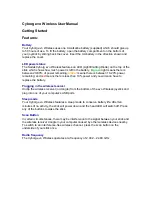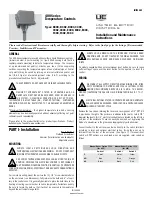
20
7 SG9H 70 en
5.4
Communication circuit board
5.4.1 Removal
Loosen the M8 stop screw (110) in the position indi-
cator (109) and turn the position indicator from the
shaft (11). Remove the inner cover (39) attached with
M3 screws (42, 3 pcs.).
Remove the M3 screws (217, 4 pcs.). Hold the sides of
the circuit board and lift it directly upwards and out-
wards. Handle the board care-fully, touching only
the sides.
5.4.2 Installation
Mount the new communication circuit board care-
fully.
Locate the pins with the matching connector on the
board. Tighten the M3 screws (217) evenly.
Install the inner cover (39).
Mount the position indicator (109) on the shaft and
tighten the M8 stop screw (110) temporarily. The
final orientation and locking of the position indicator
should be done after installation of the valve con-
troller to the actuator.
6
ERROR MESSAGES
6.1
Failsafe errors
6.2
Alarms
NOTE:
Ground yourself on the body of the device before touch-
ing the circuit board.
Ex WARNING:
Grounding of the circuit board is essential to explo-
sion protection.
The board is grounded to the housing by the mounting
screw next to the terminal blocks.
Fig. 24
Communication board
215
NOTE:
Parameter limits can only be changed via HART.
See DTM manual for setting the parameter limits.
Display message
Description
CONTINUED INTERNAL BOOT
Too many consecutive internal
resets have been generated.
FAILSAFE ACTIVATED
Device is in failsafe state.
PARAMETERS DATABASE ERROR
Parameter database initialization
failed.
PRESTAGE SHORTCUT ERROR
Prestage coil shortcut has been
detected.
SETPOINT SENSOR ERROR
Setpoint sensor defect has been
detected.
SUPPLY PRESSURE FAILSAFE
ACTIVATED
Supply pressure has dropped
below user defined alarm limit. This
causes the device to go to the
failsafe state.
Display message
Description
PNEUMATICS PROBLEM
Actuator pressure difference has
not changed even it should have
been. Spool valve may be jammed.
TOO FAST VALVE CLOSING ALARM
Valve was closed faster than was
determined by alarm limit
parameter.
TOO FAST VALVE OPENING ALARM
Valve was opened faster than was
determined by alarm limit
parameter.
TOO SLOW VALVE CLOSING ALARM
Valve was closed slower than was
determined by alarm limit
parameter.
TOO SLOW VALVE OPENING ALARM Valve was opened slower than was
determined by alarm limit
parameter.
UNINTENDED VALVE MOVEMENT
ALARM
Valve position has changed but
setpoint is still in open or close
position.
VALVE CLOSE STUCK ALARM
Over 5 % difference between
setpoint and valve position. Valve
may be jammed at close position.
Difference is a user configurable
parameter.
VALVE INTERMEDIATE STUCK
ALARM
Over 5 % difference between
setpoint and valve position. Valve
may be stuck between open and
close positions. Difference is a user
configurable parameter.
VALVE OPEN STUCK ALARM
Over 5 % difference between
setpoint and valve position. Valve
may be jammed at open position.
Difference is a user configurable
parameter.
















































